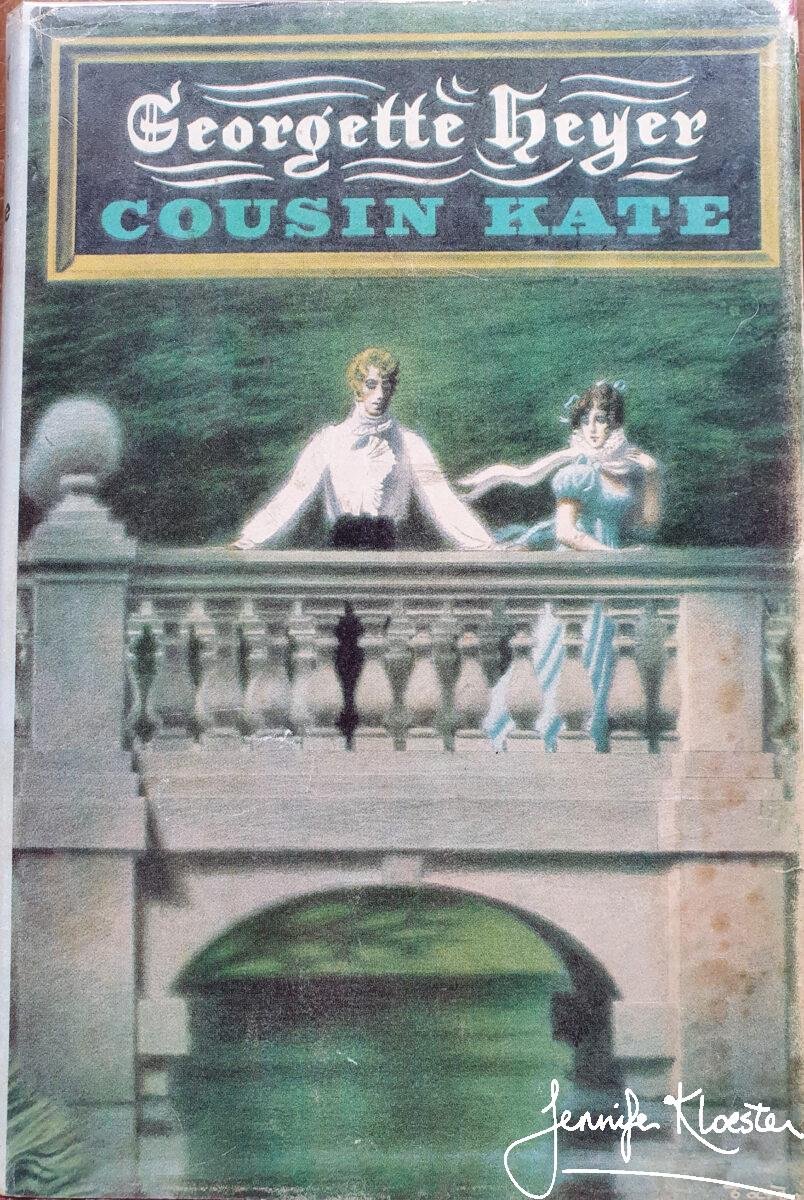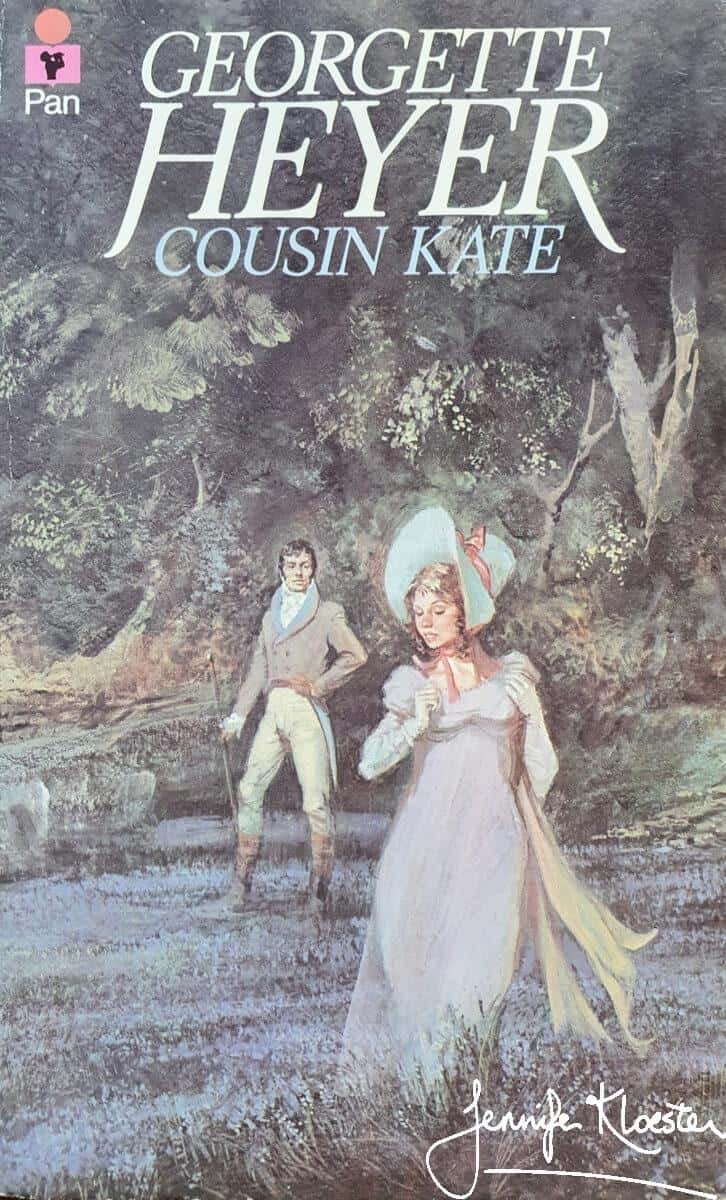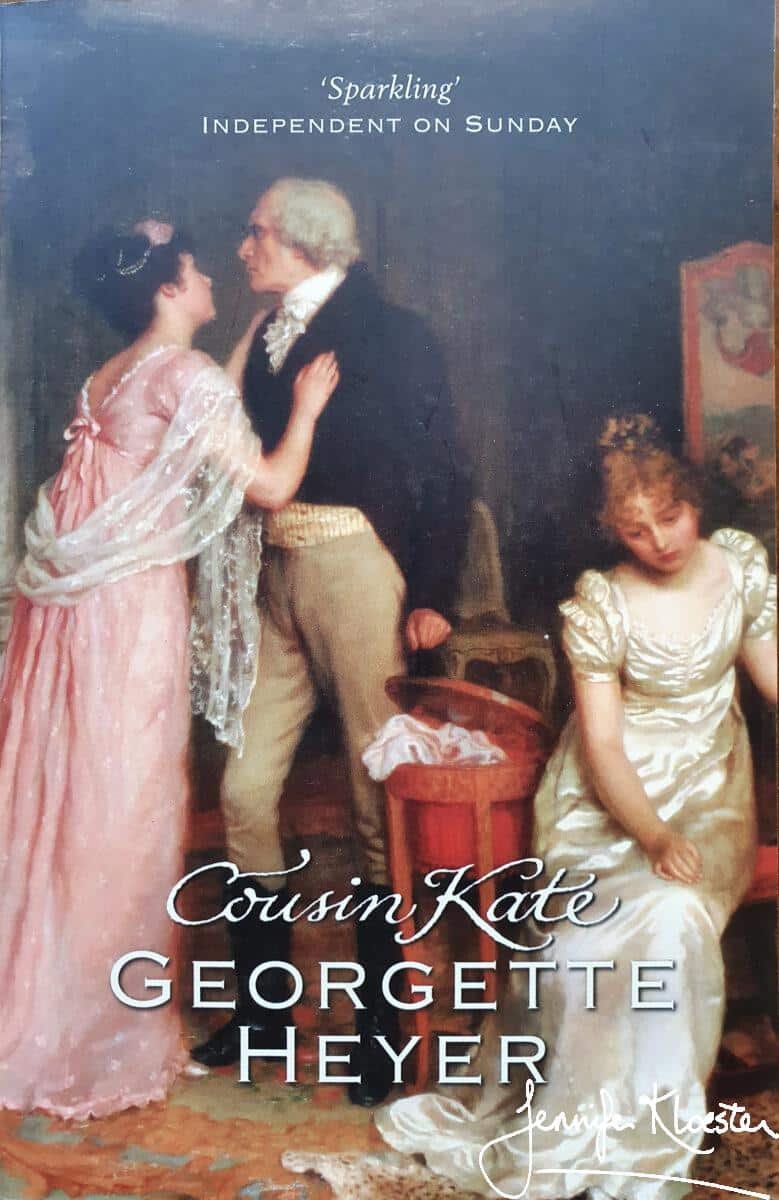“Now, don’t ask me a whole lot of questions about this epic! I know what it’s ABOUT, but I also know (knowing myself) that it will probably undergo many changes as my Fluid Pen progresses. No doubt some unforeseen person will push himself into the plot, and do his best to disrupt it. Or I shall suddenly have a change of heart.”
Georgette Heyer to Max Reinhardt, letter, 23 September 1967

Barbosa & the cover
An interesting tidbit about the original first edition cover for Cousin Kate, occurred two years after publication. In March 1970, Georgette had invited her longtime and much admired illustrator, Arthur Barbosa, to lunch at her flat in Jermyn Street to discuss the jacket for her forthcoming novel Charity Girl. Over drinks, Barbosa asked her why she “had insisted that the young man on Cousin Kate’s jacket should be portrayed in his shirtsleeves”? Georgette was stunned and afterwards told her publisher that:
“This made me goggle at him, for so far from insisting on any such thing the one fault I had to find with the picture was that in no time during the story did that young man appear in his shirt-sleeves – or, for that matter, standing in the moonlight on the bridge with Kate. As you know, I’ve never had any interest in that horrid book, so I raised no demur. It was a lovely picture, anyway. But when I learned that Barbosa’s original sketch was thrown back at him – without any reference to me! – I saw bright scarlet!
Georgette Heyer to Max Reinhardt, letter, 12 March 1970
Georgette had always cared deeply about the covers of her novels. It had taken her some years, but in the 1950s she had finally convinced her paperback publishers, Pan, to send her sketches for each new edition of her novels prior to publication. She was determined that her covers should not mislead uninitiated readers into thinking that she “was writing salacious novels”. Historical accuracy mattered a great deal to Heyer and by 1970 she had also begun to vet the covers of her novels published by Bantam.

“That Hardy Perennial Novelist”
Georgette began writing Cousin Kate in January 1968. For some time she had not been well and she was now on a course of diuretics which she assured her publisher were having “the most disintegrating effect” on her. Heyer’s health issues were to plague her for the next few years and they undoubtedly affected her writing. She was still able to write bestsellers, however, and, despite an unpleasant bout of flu, plotting the new book came as easily as it had always done. In September the previous year she had sent her publisher, Max Reinhardt, a detailed outline of Cousin Kate. It began with one of her – now habitual – moments of humorous self-deprecation:
Here also, to gladden your heart, is the information that you will (I trust) publish, sometime in the early part of next year, COUSIN KATE, a new and corny work by that Hardy Perennial Novelist, Georgette Heyer – tired, old, and semi-crippled.
Georgette Heyer to Max Reinhardt, letter, 23 September 1967
From its inception, Georgette meant Cousin Kate to be different from her other Regencies. Here there were to be no glittering London scenes, no balls or evenings at Almack’s, no handsome lords or dashing rakes – in fact, the novel would contain no immediately obvious romance – or, indeed, an immediately obvious hero! Instead, the story was to be a mystery with a strong element of suspense and several sharply depicted flesh-and-blood characters in Lady Minerva, Sir Timothy and their poor son Torquil. The central character was to be 24 year-old Kate Malvern, one of Heyer’s fiercely independent women she is pretty, spirited and intelligent. But Kate’s situation is dire because she is well-born but penniless. Not for her the glittering social whirl of a London Season, instead Kate must devise ways and means of supporting herself. Plans to continue as a governess (a truly hateful role for most women of the period as Jane Austen makes clear in Emma), or to hire herself out as a housekeeper or lady’s maid meet with a shocked rebuttal from Kate’s old nurse, Sarah Nidd. Sarah knows what is due to Kate, but without money or family, Kate’s options are extremely limited – as Georgette knew and understood all too well. There is a strong element of historical reality in Cousin Kate. Before she had written a single word, Georgette knew exactly what the book was to be about and seemed to think nothing of its being different from her other Regency novels.

Surprising
It is perhaps surprising that Georgette should devise a novel like Cousin Kate on the back of her huge success with her previous novel, Black Sheep. To pass from the wit and humour of that book to the unsettling suspense and awful ending of Cousin Kate perhaps reflects some of the strain she was feeling at the time. The Rougiers’ flat in Jermyn Street had not proved a success and her financial situation was in a state of flux. The company she had formed in 1946, Heron Enterprises, had accumulated an astonishing £80,000 – not a penny of which Georgette could touch without paying a huge sum in tax. Though she had finally found an excellent accountant in Hale Crosse, his proposed solution to her financial difficulties took her a great deal of time to process. Unsurprisingly, she worried over it and perhaps it was this, coupled with her poor health, that turned Georgette’s mind to a story about a dysfunctional family with a weak, ineffectual father, an ambitious and obsessive mother and a beautiful but mentally-ill son. This was not the first time that Heyer had written about the darker side of family life – Barren Corn (contemporary) and Penhallow (detective) were also books that read differently from the others in their genres. Cousin Kate is decidedly a Regency, but it is unlike any of Georgette’s other books set in that period. In the end the Booker Brothers scheme proved a great success and for the first time since her father’s death 43 years earlier, Georgette was finally relieved of money worries. It is worth noting that it was on the profits from their holdings of the Georgette Heyer, Agatha Christie and Ian Fleming copyrights that the Booker Prize was established in 1969. It is also worth noting that none of these bestselling authors would ever have been nominated for a Booker prize!

“The plot is one of the all-time winners”
Whatever the reasons for the very different tone and style of Cousin Kate, Georgette was enthusiastic about the book and very sure of the plot. Before ever putting pen to paper she wrote a detailed outline of the novel for Reinhardt in her usual humorous style. Using capital letters for emphasis, she also took pleasure in adding several stream-of-consciousness commands that he not interrupt her while she regaled him with the outline of her new story:
“Cousin Kate is the orphaned daughter of an impoverished Peninsular officer. Her mother died years ago, and she followed the drum with Pop. He must have been a very volatile type, because, when he died (of natural causes, after Waterloo) he left her with nothing but debts. I expect he was a gamester, or Lived Above his Income, but I’ll work that out later. Don’t interrupt! Well, there the poor girl was, aged 23, and reduced to Penury, in an age where females couldn’t waltz out, and Get a Job as easy as drop your hat. So when her dimly-remembered aunt-by-marriage, Lady (Minerva) Brede [Heyer would change this to Broome], invited her to Seek a Loving Asylum at Lynwood [later Staplewood], the seat of Sir Timothy Brede, Minerva’s aged and fairly doddering husband, she agreed to do so.
This is where the book begins. What the reader doesn’t know and you wouldn’t, unless I told you, is that Minerva, who was Poor Old Sir Timothy’s second wife, has a deep-laid and Dastardly plot in mind. Her only son, Torquil, the sole issue of her marriage, and the heir to the ancient baronetcy, and the Splendid Estate (somewhere in the Midlands), is rapidly developing into a homicidal and/or suicidal maniac. He is an incredibly beautiful youth of 19, fitfully obsessed by a Persecution Complex, and believed by fond, doting father to be physically so delicate that he had to be educated at home, and couldn’t be exposed to the rigours of life at either University.
I shall have to introduce a bribed physician, but I know ALL about his smiling “valet” already, so DO stop interrupting with quite idiotic caveats, Max! Anyway, Minerva, who is beautiful and clever, and completely hardboiled, knows her son is going to come to a sticky end sooner or later (and probably sooner) unless her is kept under restraint, and she conceives the happy idea of marrying him to her providentially orphaned niece-by-marriage, who has no other relations to worry about her, or to make trouble. With a son-and-heir in view, of course. After which, Torquil can commit suicide without prejudicing her position as Queen Bee of Lynwood – for, naturally, the poor little friendless widow [Kate] will allow herself to be dominated by her beautiful and ever-so kind mother-in-law. Sir Timothy, you must know, is not expected to live for very much longer.”
Georgette Heyer to Max Reinhardt, letter, 23 September 1967
The Sunday Times declared the plot as “One of the All-time winners … beautifully rendered”. Many readers would agree although there are lots who find Cousin Kate and uncomfortable novel and – unlike most Georgette Heyer novels – not one to which they often return.

A Gothic novel?
However, there is much to interest the reader in Cousin Kate which has several remarkably well-drawn characters. Some reviewers have called Cousin Kate a “Gothic” story and it does meet several of the criteria for that particular genre, with its young orphaned heroine taken off to a great house by a mysterious and somewhat sinister matriarch, there to meet that lady’s strange, though beautiful son. Whether Georgette really intended her new book to be a Gothic novel or merely a romance with an unusual degree of tension is not entirely clear. A blog at First Impressions Reviews has suggested that if Emily Brontë’s Wuthering Heights and Daphne du Maurier’s Rebecca had produced a baby, that child would be Cousin Kate. and it is possible that Heyer’s story was influenced by her reading and admiration of those authors. Lady Minerva Broome is perhaps the most sinister person in the entire Heyer canon and a study in the effect of ruthless ambition on the lives of those around her. Minerva is the aunt whom Kate has never known before that imperious lady sweeps in and takes her niece off to an apparent life of luxury at Staplewood (home to the Broomes for over 200 years). Here Kate meets her cousin Torquil: “the most beautiful youth Kate had ever seen”. But there is more to Torquil than meets the eye and Kate is soon beset by anxiety over her unpredictable cousin. As the novel progresses Kate’s growing awareness of Torquil’s precarious mental state runs parallel to her Aunt Minerva’s increasing desperation to achieve her secret ambition for her son.

“What will happen to Torquil”
Torquil stands alone among Heyer’s characters as the only one to suffer from a form of madness – what we would call today a mental health problem. Georgette had her own direct experience of depression for both her mother and her younger brother Boris had suffered from what was then called “manic depression” but today would be called bipolar disorder. Throughout the book her sympathy for Torquil is apparent but his mother’s treatment of him and her Machiavellian scheming are ultimately too much for his fragile mind. though. Even when plotting Cousin Kate Georgette had an inkling of Torquil’s likely end:
I don’t quite know yet what will happen to Torquil: he may drown himself in the lake – I’ll put one in , just in case I find a need it – but I daresay he will just be put under the afore-mentioned restraint. It doesn’t much matter, so I’ll let things take their own course.”
Georgette Heyer to Max Reinhardt, letter, 23 September 1967
Once she began writing, however, by chapter 4 Georgette knew exactly what would happen to the poor young man. She foreshadowed his untimely end by allowing Torquil to speak Shakespeare’s famous lines from Hamlet to Kate. He quotes Queen Gertrude telling Laertes about his sister Ophelia’s death by drowning:
Gertrude: There is a willow grows aslant a brook, That shows his hoar leaves in the glassy stream; There with fantastic garlands did she come Of crow-flowers, nettles, daisies, and long purples That liberal shepherds give a grosser name, But our cold maids do dead men's fingers call them: There, on the pendent boughs her coronet weeds Clambering to hang, an envious sliver broke; When down her weedy trophies and herself Fell in the weeping brook. Her clothes spread wide; And, mermaid-like, awhile they bore her up: Which time she chanted snatches of old tunes; As one incapable of her own distress, Or like a creature native and indued Unto that element: but long it could not be Till that her garments, heavy with their drink, Pull'd the poor wretch from her melodious lay To muddy death. Hamlet, Act 4, scene vii
Not exactly a romance?
Georgette’s somewhat surprising plot for Cousin Kate was met with enthusiasm by Heyer’s publisher. By now she had built a huge audience for her books and was topping the bestseller lists in countries around the world. To her surprise, and despite its unusual tone, Cousin Kate would soon see another enormous success. for Heyer. Though the novel would not become an immense fan favourite like so many of Georgette Heyer’s other books, it remains an eminently readable book. And though not a romance like her other Regencies, Cousin Kate does have a touching romance between its eponymous heroine and Torquil’s dynamic cousin, Philip Broome. As Georgette told her publisher at the outset:
“Yes, I heard what you said, and really, Max, how can you be so dumb. Of course there’s a Hero! Do you think I was born yesterday? He may look like the villain of the Piece, but he’s no such thing. Nor is Kate the lovely, innocent half-wit her face and her pretty manners might lead you to suppose.
By mid-April 1968, with Cousin Kate more than half finished, Georgette’s view of the novel had taken a decidedly negative turn. Whether she genuinely meant it, or whether it was more of her habitual self-deprecation, is unknown. She could not help writing to her publisher, however, to offer a rather miserable account of the book. That time would prove her wrong – Cousin Kate would top the bestseller lists and fans loved it – in now way changed her opinion of this, her third-last novel:
I shall hope to see you and Joan when this Scourge is removed from my back. Do you want a blurb for it? Here’s one for you:
“This dreary romance, we confidently predict, will disappoint Miss Heyer’s many admirers. It is almost totally devoid of wit, or, in fact, interest. It is not even well-written; & will, I believe, become a valuable addition to the library, as the worst book she has ever written. Order your copy now!”
Georgette Heyer to Max Reinhardt, letter, 1 April 1968
She was wrong!
For your delectation, a few quotations from Heyer’s letters in the months following the publication of Cousin Kate:
You will be pleased to know about the following comment from our New Zealand representatives, who have placed a very handsome order: “It is, incidentally, an excellent Heyer and those booksellers who have read the proof are immensely enthusiastic. It is clearly going to be one of the major Christmas bestsellers in this country.”
Max Reinhardt to Georgette Heyer, letter, 22 July 1968
Isn’t it pleasant to see COUSIN KATE at the top of the best-seller list the very first week of publication?
Max Reinhardt to Georgette Heyer, letter, 2 October 1968
Oh, will you please ask Belinda, if she will arrange to have three more copies of Kate sent to me? I am stunned & disgusted by the number of people who want her! Would you believe it? — Carola Oman & Richard, two persons whose taste in literature is usually to be relied on, are positively enthusiastic about Kate! My own opinion of her has undergone no change
Georgette Heyer to Max Reinhardt, letter, 25 November 1968
‘I wrote my last book under quite ghastly disabilities, and why it is the season’s best-selling novel is something which I shall never understand – for, I promise you, it STINKS!’; ‘from what you write I have a grim suspicion that you’ve actually READ COUSIN KATE!’; ‘I accept the fervent assurances of my son and my brothers (my most severe critics) that they thought her (a) Very good! (b) Different, but MOST interesting; and (c) Compulsive! As evidence of their desires to bolster up my failing morale – but I don’t believe a word of their kindly encomiums, and they don’t change my opinion of Kate!’
Georgette Heyer to Isabella Banton, letter, 17 December 1968
The fact that that lamentable effort has earned, to date, £12,728 (over £200,000 in today’s money) in no way changes my opinion of it!’
Georgette Heyer 1969
“you wouldn’t believe the number of Rave letters I’ve had about COUSIN KATE, which must surely take a prominent position among the worst books I’ve ever written.
Georgette Heyer to Max Reinhardt, letter, 30 January 1970





4 thoughts on “Cousin Kate – a Gothic novel?”
I would love someone to write a side by side analysis of Lady Broome and Lady Dolphinton. Both ambitious women with sons who have a special need.
Oooh, that IS a good idea. I’ll add it to my list of monthly topics to write once I’ve posted the last three book blogs. Thanks so much for posting Cassandra.
Minerva most sinister? Yes of the women because I think she’s more intelligent than Dolph’s awful mother. But I find Francis Cheviot the most sinister. To smile and smile and be a villain. To murder his friend and see it as a duty. He beats Bad Basil hands down, again I think because of intelligence.
Is it a Gothic novel? Yes we have sinister servants – or one if them. Sidley is one of the most unpleasant. Yes the scheming aunt/vampire, the mad non hero who is eventually turned into an object of pity.
But GH also employs the Jane Austen touch. Staplewood is no more a Gothic cadtke than Northanger Abbey. And we have the almost Shakespearean yokels, Sarah and her father in law. Without them the book would lose a lot of its charm.
I love your explanations and this lovely, perceptive post. Thank you. Yes, I do agree about Sarah and her wonderful father-in-law – such great characters and the book would definitely lose a vital dimension without them. It’s such an interesting book with such a variety of characters.